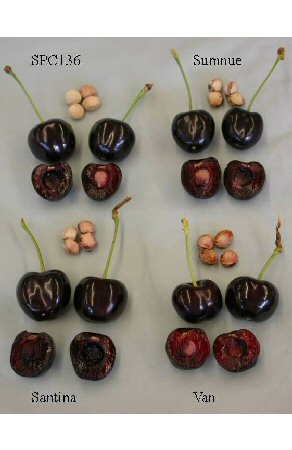SPC136
| Denomination: | 'SPC136' |
|---|---|
| Previously Proposed Denomination: | '13S-13-09' |
| Botanical Name: | Prunus avium |
| Applicant/Holder: |
Agriculture & Agri-Food Canada, Summerland Pacific Agri-Food Research Centre Highway 97 Summerland, British Columbia V0H 1Z0 Canada |
| Breeder: |
David W. Lane, Agriculture & Agri-Food Canada, Summerland, British Columbia |
| Agent in Canada: |
Summerland Varieties Corp. (SVC) 105-13677 Rosedale Avenue Summerland, British Columbia V0H 1Z5 Canada Tel: 778-516-8016 |
| Application Date: | 2005-07-05 |
| Application Number: | 05-5011 |
| Grant of Rights Date: | 2007-11-19 |
| Certificate Number: | 2991 |
| Grant of Rights Termination Date: | 2025-11-19 |
Variety Description
Varieties used for comparison: 'Van', 'Sumnue' (Cristalina) and 'Santina'
Summary: 'SPC136' is a non-self fertile, sweet cherry variety which has larger flowers with wider petals than the three reference varieties. The fruit and the stone of 'SPC136' are larger than the fruit and stone of 'Van', 'Sumnue' and 'Santina'. 'SPC136' has a less prominent suture than 'Van' and 'Santina' which have a very prominent suture. The fruit stalk of 'SPC136' is longer than any of the reference varieties. 'SPC136' matures very early to early, after 'Santina' and before 'Van'.
Description:
TREE: normal type, medium vigour, upright growth habit, medium crown density
ONE-YEAR OLD SHOOT: no anthoycanin, erect attitude, medium thickness, short to medium internodes, no pubescence, many lenticels, very few or no flower buds
VEGETATIVE BUD: large size, conical to round, adpressed to slightly held out from shoot, medium sized bud support
CURRENT YEAR'S SHOOT: no pubescence, no anthocyanin at tip
LEAF: horizontal to oblique downwards attitude, broad obovate to elliptical shape, acute angle at tip, U-shaped base, acuminate apex, slightly concave in profile, weak to medium pubescence on lower side
UPPER SIDE OF LEAF BLADE: dark green, no anthocyanin colouration, weak glossiness, yellow before leaf fall
LEAF BLADE MARGIN: biserrate, medium depth indentations
PETIOLE: anthocyanin present
NECTARIES: usually three, red colour, kidney shaped
FLOWER: medium flowering density, borne in clusters, single type, white bud
PEDICEL: medium thickness, no pubescence
PETAL: medium to large size, round shape, overlapping margins, light pink colour
ANTHER: yellow before dehiscence, pollen present
PISTIL: normal, no supplementary pistil, no pubescence on ovary
FRUIT: very large, kidney shaped, flattened to rounded in lateral view, largest diameter towards middle, flat to pointed apex
FRUIT SKIN: wine red, few light coloured medium sized dots, low prominence of suture, moderately susceptible to rain-induced cracking
FRUIT JUICE: dark red to black
FRUIT FLESH: dark red to purple, firm, low acidity, medium sweetness, strong juiciness
FRUIT STALK: long, medium thickness
STONE: non-adherent to flesh, large size, medium size relative to fruit, obovate in front view, intermediate in lateral view, round in basal view, symmetrical, strong keel development
PERFORMANCE CHARACTERISTICS: intermediate fruiting precocity, late flowering, not self-fertile, very early to early fruit maturity, medium fruit setting
Origin & Breeding History: 'SPC136' was the result of the cross '2S-36-36' x 'Summit', which was made at the Pacific Agriculture Research Centre, Agriculture and Agri-Food Canada, Summerland, B.C. in 1981. The parent '2C-36-36' was a Summerland breeding line which was not commercially viable and which was later dropped from the breeding programme. The seedling cross was designated 'SPC136' in 1997. Two propagations were made on Prunus avium rootstock and planted out in a trial block at the Summerland Research Centre in 1987. Evaluation of the selection began upon fruiting. The variety 'SPC136' was selected on the basis of maturity date, size of fruit, firmness, field splits, fruit shape, skin and flesh colour, fertility, luster, productivity and precocity.
Tests & Trials: Trials for 'SPC136' were conducted at the Pacific Agriculture Research Centre, Agriculture and Agri-Food Canada, Summerland, British Columbia from 2003 to 2005. The candidate variety and three reference varieties were planted in close proximity in test blocks located in Field 4 and 13. The trials consisted of 4 trees per variety, grafted onto 'Mazzard' rootstock. Measured observations were based on a minimum of 15 measurements.
Comparison tables for 'SPC136' with reference varieties 'Van', 'Sumnue' and 'Santina'
Leaf blade length (mm)
| 'SPC136' | 'Van' | 'Sumnue' | 'Santina' | |
|---|---|---|---|---|
| mean | 170.3 | 165.7 | 188.9 | 184.8 |
| std. deviation | 17.4 | 17.0 | 12.7 | 11.4 |
Leaf width (mm)
| 'SPC136' | 'Van' | 'Sumnue' | 'Santina' | |
|---|---|---|---|---|
| mean | 86.1 | 68.6 | 76.0 | 84.3 |
| std. deviation | 6.5 | 7.9 | 6.1 | 6.1 |
Petiole length (mm)
| 'SPC136' | 'Van' | 'Sumnue' | 'Santina' | |
|---|---|---|---|---|
| mean | 36.4 | 38.1 | 41.6 | 41.8 |
| std. deviation | 3.8 | 3.3 | 13.8 | 5.3 |
Diameter of corolla (mm)
| 'SPC136' | 'Van' | 'Sumnue' | 'Santina' | |
|---|---|---|---|---|
| mean | 42.3 | 39.3 | 38.1 | 39.7 |
| std. deviation | 2.5 | 1.6 | 1.8 | 1.1 |
Fruit weight (gm)
| 'SPC136' | 'Van' | 'Sumnue' | 'Santina' | |
|---|---|---|---|---|
| mean | 13.0 | 9.8 | 10.1 | 10.0 |
Length of fruit stalk (mm)
| 'SPC136' | 'Van' | 'Sumnue' | 'Santina' | |
|---|---|---|---|---|
| mean | 54.4 | 40.1 | 47.1 | 42.1 |
| std. deviation | 2.9 | 5.2 | 4.7 | 3.1 |
Click on image for larger view

Cherry: 'SPC136' (top left) with reference varieties 'Sumnue' (top right), 'Santina' (bottom left) and 'Van' (bottom right)
- Date modified: